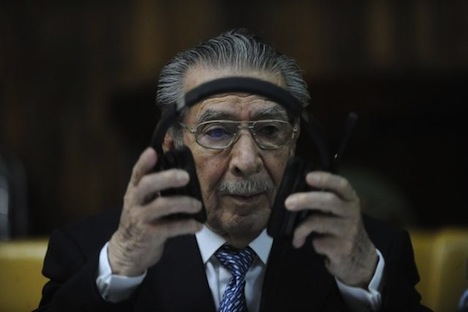It’s hard to know exactly what to think, but I certainly didn’t expect former Guatemalan president Efraín Ríos Montt to be treated so harshly by a tribunal in his own country.![]()
Tonight brings word that Ríos Montt, at age 86, has been convicted of genocide and crimes against humanity, with a sentence of 80 years in total — it’s the first time a country has ever tried or convicted a former leader for genocide.
It’s a breathtaking victory for human rights — even by the grueling standards of the Cold War, the terror that Ríos Montt wreaked on the indigenous inhabitants of Guatemala’s highlands was inexcusable. The death of up to 10,000 Guatemalans during a reign of 17 months is really quite something and, though justice has come 30 years after Ríos Montt left office, the fact of the matter is that justice has now come to a country that spend far too much of the Cold War impoverished and embattled in civil war.
It’s also a somber verdict for the United States and the administration of former U.S. president Ronald Reagan, which horrifically supported Ríos Montt with vigor, in part because of his ties to evangelical Christians, and his ties to the Republican establishment in the United States continue to this day — his daughter, Zury Ríos Montt, is married to former Illinois Republican congressman Jerry Weller. There are, of course, poor marks for every U.S. presidential administration, but the wanton disregard for human rights during the early 1980s sets the Reagan administration’s support for Ríos Montt aside as a particularly egregious oversight in an era of bipartisan disregard for sovereignty throughout Latin America.
Though I doubt it will make top headlines in the United States, any U.S. citizen on the left or the right should be horrified by what Ríos Montt and his administration perpetrated, and even more horrified that the United States so breezily facilitated it.
I don’t mean to be unduly partisan — you can lay any number of tragedies in foreign lands at the feet of many U.S. presidents, Democrat and Republican. For Guatemala, though, the involvement of the U.S. Central Intelligence Agency in overthrowing the leftist, though duly elected, Guatemalan president Jacobo Árbenz in 1954 was a catalyst for the civil war and turmoil that the country would face for the next four decades. Though it happened on the watch of U.S. president Dwight Eisenhower and U.S. secretary of state John Foster Dulles, the uprooting of developing nations during the Cold War, especially in Latin America, was a bipartisan venture.
But as I wrote in February, the Ríos Montt administration escalated what had already been by that point three decades of civil war:
Ríos Montt, like many Guatemalan leaders of the period, came to power from an army coup in March 1982 after a round of particularly fraudulent elections, and Guatemala, then locked into its third decade of civil war between Marxist rebels and the army-backed state, was certainly not new to atrocities.
But what followed in the 17 months of Ríos Montt’s reign, as recounted and recorded in at least two truth and reconciliation commissions in subsequent years, outpaced what had come before, especially with regard to an indigenous population caught in the crosshairs in the showdown between army and rebel forces.
Spearheading a campaign referred to as ‘frijoles y fusiles’ (beans and guns), the message from Ríos Montt was clear: support us and we’ll feed you; otherwise, we’ll kill you. The military, allegedly under orders from Ríos Montt, engaged a scorched-earth campaign against the indigenous highlanders, destroying hundreds of Mayan villages, killing tens of thousands, and displacing hundreds of thousands more.
Guatemala still faces challenges — its current president, Otto Pérez Molina, who was serving in the Guatemalan military in the 1980s, has been linked to some of the Ríos Montt-era atrocities.
In a world where two officials México and Brazil have been competing to become the secretary-general of the World Trade Organization, it’s sometimes difficult to fathom how far Latin America has come since the end of the Cold War, and how the nature of U.S.-Latin American relations have vastly transformed between 1983 and 2013, in almost all ways for the betterment of both the United States and Latin America.
But in many ways, aside from Panamá (for its canal) and Costa Rica (for its tourism), the rest of Central America is often an afterthought of U.S. foreign policy, even within Latin American policy. That’s a shame, because Central America, and especially Guatemala, suffered even more than the rest of Latin America during the Cold War, and the entire region today bears the scars of that experience in its relative lack of development and economic dynamism and the relative instability of its legal and electoral institutions. Excluding Panamá and Costa Rica, which have their peculiar idiosyncrasies, the remaining four Central American countries are part of the eight worst countries in Latin America in terms of GDP per capita.
Nonetheless, the Ríos Montt verdict is at least an opportunity for Guatemala to draw a bright line from a nasty, brutal time in its history — perhaps even into a brighter future that brings more prosperity not just to indigenous Mayan cultures but to all Guatemalans and all of Central America.
Photo credit to Johan Ordóñez of AFP.
